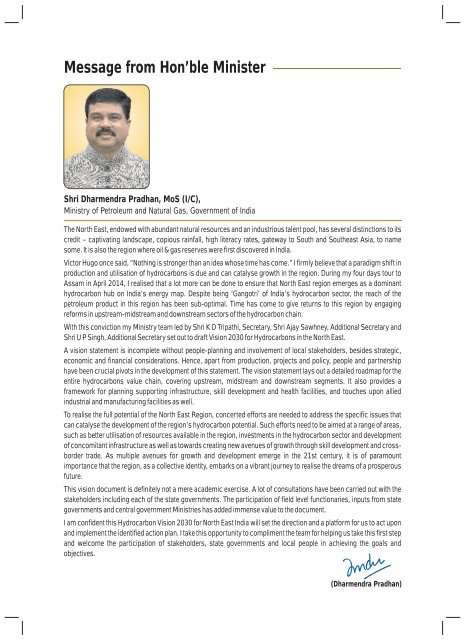Hydrocarbon Vision 2030 (ஹைட்ரோகார்பன் தொலைநோக்கு ஆவணம் 2030)
You also want an ePaper? Increase the reach of your titles
YUMPU automatically turns print PDFs into web optimized ePapers that Google loves.
Message from Hon’ble Minister<br />
Shri Dharmendra Pradhan, MoS (I/C),<br />
Ministry of Petroleum and Natural Gas, Government of India<br />
The North East, endowed with abundant natural resources and an industrious talent pool, has several distinctions to its<br />
credit – captivating landscape, copious rainfall, high literacy rates, gateway to South and Southeast Asia, to name<br />
some. It is also the region where oil & gas reserves were first discovered in India.<br />
Victor Hugo once said, “Nothing is stronger than an idea whose time has come.” I firmly believe that a paradigm shift in<br />
production and utilisation of hydrocarbons is due and can catalyse growth in the region. During my four days tour to<br />
Assam in April 2014, I realised that a lot more can be done to ensure that North East region emerges as a dominant<br />
hydrocarbon hub on India’s energy map. Despite being ‘Gangotri’ of India’s hydrocarbon sector, the reach of the<br />
petroleum product in this region has been sub-optimal. Time has come to give returns to this region by engaging<br />
reforms in upstream-midstream and downstream sectors of the hydrocarbon chain.<br />
With this conviction my Ministry team led by Shri K D Tripathi, Secretary, Shri Ajay Sawhney, Additional Secretary and<br />
Shri U P Singh, Additional Secretary set out to draft <strong>Vision</strong> <strong>2030</strong> for <strong>Hydrocarbon</strong>s in the North East.<br />
A vision statement is incomplete without people-planning and involvement of local stakeholders, besides strategic,<br />
economic and financial considerations. Hence, apart from production, projects and policy, people and partnership<br />
have been crucial pivots in the development of this statement. The vision statement lays out a detailed roadmap for the<br />
entire hydrocarbons value chain, covering upstream, midstream and downstream segments. It also provides a<br />
framework for planning supporting infrastructure, skill development and health facilities, and touches upon allied<br />
industrial and manufacturing facilities as well.<br />
To realise the full potential of the North East Region, concerted efforts are needed to address the specific issues that<br />
can catalyse the development of the region’s hydrocarbon potential. Such efforts need to be aimed at a range of areas,<br />
such as better utilisation of resources available in the region, investments in the hydrocarbon sector and development<br />
of concomitant infrastructure as well as towards creating new avenues of growth through skill development and crossborder<br />
trade. As multiple avenues for growth and development emerge in the 21st century, it is of paramount<br />
importance that the region, as a collective identity, embarks on a vibrant journey to realise the dreams of a prosperous<br />
future.<br />
This vision document is definitely not a mere academic exercise. A lot of consultations have been carried out with the<br />
stakeholders including each of the state governments. The participation of field level functionaries, inputs from state<br />
governments and central government Ministries has added immense value to the document.<br />
I am confident this <strong>Hydrocarbon</strong> <strong>Vision</strong> <strong>2030</strong> for North East India will set the direction and a platform for us to act upon<br />
and implement the identified action plan. I take this opportunity to compliment the team for helping us take this first step<br />
and welcome the participation of stakeholders, state governments and local people in achieving the goals and<br />
objectives.<br />
(Dharmendra Pradhan)

















